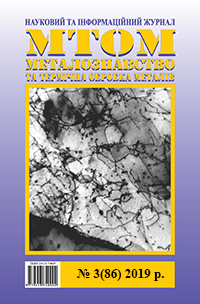Research of corrosive properties of titanium for additive technologies
DOI:
https://doi.org/10.30838/J.PMHTM.2413.250619.58.323Keywords:
additive technologies, titanium, corrosion resistance, 3D surfacing, non-spherical powder of titanium, HDH powder of titaniumAbstract
Abstract. The difference of foreign alloys prevents wide distribution of additive technologies on chemical composition used in a home production. The work is devoted to research on corrosion resistance of the alloy of VТ1−0 obtained by additive technologies from home powder of titanium. It is shown that the use of non-spherical powders of titanium for additive technologies results in formation of low level of corrosive properties, that requires the realization of additional research in this area. An assessment of the corrosion resistance of the studied samples showed that the corrosion rate of the deposited powder alloy VT1−0 exceeds the corrosion rate of the alloy VT20 obtained by the traditional manufacturing technology (pressure treatment method) by 2.7 times. At the same time, the corrosion rate of the transition zone is somewhat lower than that of the powder deposited titanium VT1−0, but higher than that of the deformed VT20 alloy and is 0.394 g / (m2 × year). The probable reason for the occurrence of significant difference in the rates of corrosion destruction of VT1-0 and VT20 alloys may be the presence of a significant amount of internal defects in the deposited powder material VT1−0. In this regard, it should be assumed that in order to increase the corrosion resistance of additive electron-beam surfacing performed by using VT1−0 grade titanium powder, the primary task is to minimize the probability of formation of internal defects in the deposited layers. As a rule, improvement of the quality of electron-beam surfacing is achieved by selecting and optimizing technological modes (beam current, travel rate of beam gun, thickness of the applied powder layer, etc.).
References
Osnovnye svedeniya o titane i ego splavah [Basic information about titanium and its alloys]. Elektronnyy resurs. (in Russian).
Turichin G.A., Klimova O.G., Zemlyakov E.V., Babkin K. and Somonov V. Tehnologicheskie osnovy vysokoskorostnogo pryamogo lazernogo vyraschivaniya izdeliy metodom geterofaznoy poroshkovoy metallurgii [Technological basis of high-speed direct laser growing products using heterophase powder metallurgy]. Fotonika [Photonics]. 2015, no. 4, p. 52. (in Russian).
Mihaylyutenko A.V., Basov Yu.F. and Ovchinnikov A.V. Primenenie additivnyh tehnologiy dlya proizvodstva detaley gazoturbinnyh dvigateley s ispol'zovaniem perspektivnyh poroshkov titanovyh splavov [Application of additive technologies for the production of parts of gas turbine engines using advanced powders of titanium alloys]. Materialy dokladov mezhdunarodnoi nauchno-tekhnicheskoi konferentsii 22−24 iiunia 2016 g [Materials of reports of the international scientific and technical conference (June 22–24, 2016)]. Pp. 36−37. (in Russian).
Kovalenko T.A. and Ovchinnikov A.V. Vliyanie ishodnoy struktury na mehanizmy razrusheniya i mehanicheskie svoystva submikristallicheskogo titana [The influence of the initial structure on the mechanisms of destruction and mechanical properties of submicrocrystalline titanium]. Novі materіali і tehnologії v metalurgії ta mashinobuduvannі [New materials and technologies in metallurgy and machine-building]. 2010, no. 1, pp. 72−80. (in Russian).
Tomashov N.D. and Al'tovskiy R.M. Korroziya i zaschita titana [Corrosion and protection of titanium]. Moscow : Mashgiz, 1963, p. 168. (in Russian).
Petrik I.A., Ovchinnikov A.V. and Seliverstov A.G. Razrabotka poroshkov titanovyh splavov dlya additivnyh tehnologiy primenitel'no k detalyam GTD [Development of titanium alloy powders for additive technologies in relation to GTE parts]. Aviacionno-kosmicheskaya tehnika i tehnologiya [Aerospace Engineering and Technology]. 2015, no. 8, pp. 11−16. (in Russian).
Ovchinnikov A.V., Basov Yu.F., Petrik I.A., Skrebcov A.A. and Marchenko Yu.A. Realizaciya additivnyh processov svarki pri proektirovanii i proizvodstve detaley gazoturbinnyh aviadvigateley [Implementation of additive welding processes in the design and manufacture of parts for gas turbine aircraft engines]. Aviacionno-kosmicheskaya tehnika i tehnologiya [Aerospace Engineering and Technology]. 2017, no. 7(142), p. 140. (in Russian).
Puchkov Yu.A., Berezina S.L. and Sedova L.A. Vliianie rastiagivaiushchikh napriazhenii na korrozionnuiu stoikost v morskoi srede a+ b-titanovogo splava VT22 [Effect of tensile stresses on corrosion resistance in the marine environment of a+ b-titanium alloy VT22]. Nauka i Obrazovanie [Science and education]. MSTU named N.E. Bauman. [Electronic journal]. 2015, no. 04, pp. 336−348. (in Russian).
Downloads
Published
Issue
Section
License
Authors that are published in this journal agree to follow the conditions:
Authors reserve the right to the authorship of his work and cede the right to the journal of first publication of this work on conditions of the license under the Creative Commons Attribution License, which allows others to distribute it freely with the obligatory reference to the author of the original work and the first publication of the work in this journal.

